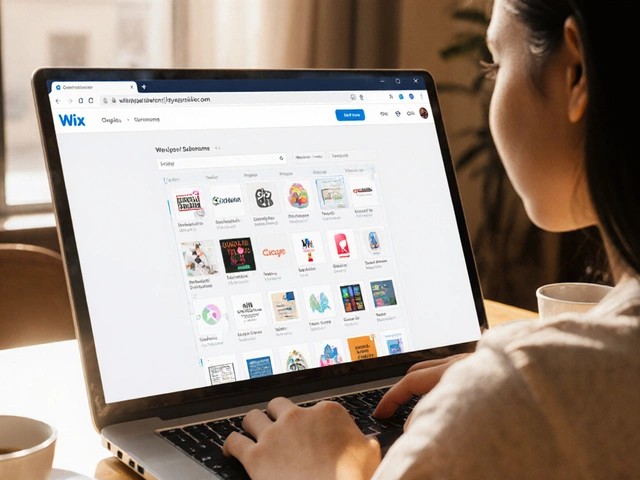Blog Income Calculator
Estimate your potential blog earnings based on real industry data. Adjust inputs to see how traffic volume and monetization methods impact your income.
Adjust your inputs to see your potential earnings.
Key Takeaways
- Only a minority of bloggers make money consistently; most earn under $100 a month.
- Revenue comes from a handful of methods: ads, affiliates, sponsorships, digital products and memberships.
- Traffic volume, niche profitability, and audience trust are the three biggest earnings drivers.
- Setting realistic goals and diversifying income streams raises your chances of turning a blog into a side‑hustle or full‑time business.
- A step‑by‑step checklist can help you move from hobbyist to paid creator.
Ever wondered if the glitter you see on success stories is the norm or the exception? The short answer is that most bloggers are individuals who write and publish articles online, often driven by passion or a desire to share expertise don’t earn a steady paycheck from their sites. But the full picture is richer than a simple yes or no. Let’s break down the numbers, the common ways people monetize, and the real factors that decide whether a blog can pay the bills.
What the Numbers Really Say
Industry surveys from 2023‑2024 consistently show that about 10‑15% of active blogs generate any amount of revenue, and only 3‑5% pull in more than $1,000 per month. The median earnings for all blogs sit roughly between $5 and $30 per month - enough for a cup of coffee, but not enough to replace a day job.
These figures come from sources like the Blog Cashflow Survey (2024) and the Affiliate Marketing Benchmark Report (2023), which pooled data from over 5,000 sites spanning hobby blogs, niche experts, and professional media outlets.
How Bloggers Turn Content into Cash
There are six main revenue streams you’ll see time and again. The table below shows typical earnings ranges, required traffic levels, and the effort involved.
| Method | Typical Monthly Earnings | Needed Monthly Pageviews | Setup Complexity |
|---|---|---|---|
| Advertising refers to display ads placed on a blog, usually via an ad network like Google AdSense | $5‑$300 | 10K‑100K | Low |
| Affiliate Marketing involves promoting third‑party products and earning a commission on each sale or lead | $10‑$2,000 | 5K‑50K | Medium |
| Sponsored Posts are paid articles written for a brand that wants exposure to the blog’s audience | $50‑$5,000 per post | 30K‑200K | Medium‑High |
| Digital Products include e‑books, online courses, templates, or software sold directly to readers | $100‑$10,000 | 10K‑100K | High |
| Membership Site offers exclusive content or community access behind a recurring subscription fee | $200‑$8,000 | 20K‑150K | High |
| Consulting / Services leverages the blog’s authority to sell personal coaching, SEO audits, or freelance work | $300‑$15,000 | 5K‑30K | Medium‑High |

Why Most Blogs Struggle to Earn Money
Three core factors separate the few high‑earning sites from the many that stay in the red.
- Traffic volume and quality. Without a steady stream of visitors, even the best monetization tools generate pennies. Niche blogs that attract 10‑20K monthly visitors already have a foothold; broader topics often need 100K+ to see meaningful ad revenue.
- Niche profitability. Finance, health, and software tend to command higher-paying ads and affiliate programs than lifestyle or travel. A blogging niche is the specific subject area a blog focuses on, such as personal finance or vegan cooking with high buyer intent will convert better.
- Audience trust. Readers who see you as an authority are more likely to click affiliate links, buy your products, or sign up for a membership. Trust is built through consistent, high‑quality content and transparent disclosures.
Realistic Income Expectations for Different Stages
Below is a quick snapshot of what a typical blogger might earn at each stage of growth.
- Starter (0‑1K monthly pageviews): Mostly hobby, maybe $0‑$20 from ad clicks.
- Growth (1‑10K pageviews): Affiliate commissions begin to appear, $20‑$200 per month.
- Established (10‑50K pageviews): Mix of ads, affiliates, and occasional sponsored post, $200‑$2,000.
- Professional (50K+ pageviews): Diversified income, often $2,000‑$10,000+ depending on products and sponsorships.
Most bloggers plateau in the growth phase, never hitting the professional tier unless they invest in SEO, product creation, or a dedicated sales funnel.
Steps to Boost Your Chances of Making Money
Turning the odds in your favor isn’t magic; it’s a series of focused actions.
- Pick a profitable niche a subject area with an audience willing to spend money on related products or services. Research keyword CPC and affiliate commission rates.
- Invest in SEO basics: keyword research, on‑page optimization, and backlink building. Even a 20% traffic lift can double earnings.
- Start with low‑friction monetization - Google AdSense is an ad network that automatically serves relevant display ads on a website or a simple Amazon affiliate link.
- Scale to higher‑ticket items once you have 5‑10K monthly visitors. Create an e‑book or a short video course that solves a specific problem.
- Validate the idea with a survey or a free downloadable resource.
- Price based on perceived value - $19‑$99 works for most niche guides.
- Build an email list. Even a 1% conversion rate on a list of 2,000 subscribers yields $200‑$500 per month.
- Offer a lead magnet (checklist, template) to grow the list.
- Send regular, value‑first newsletters and occasional product pitches.
- Reach out for sponsored posts once you hit 30K‑50K pageviews. Show brands your niche relevance, audience demographics, and past performance.
- Start with a modest rate (e.g., $150 per post) and increase as traffic grows.
Remember, diversification is key. Relying on just ads leaves you vulnerable to algorithm changes or ad‑blocker usage.
Common Pitfalls to Avoid
- Chasing vanity metrics like follower counts instead of actual revenue.
- Choosing a niche solely because it’s popular, not because it matches audience buying intent.
- Placing too many ads early on - it hurts user experience and SEO.
- Skipping legal disclosures, which can lead to trust loss or penalties.
- Neglecting content quality while focusing only on sales copy.
Quick Checklist for a Money‑Making Blog
- Identify a profitable niche with clear buyer intent.
- Set up a clean, fast WordPress site with essential SEO plugins.
- Publish at least 12 pillar articles targeting high‑volume keywords.
- Enable a low‑friction ad network (e.g., AdSense).
- Add 3-5 relevant affiliate links per article.
- Create one lead magnet and start building an email list.
- Plan a digital product to launch once traffic hits 10K monthly pageviews.
- Track earnings, traffic, and conversion rates weekly.
Frequently Asked Questions
Do all bloggers eventually earn money?
No. Earnings depend on traffic, niche profitability, and the willingness to monetize. Many blogs stay hobby projects without any income.
What’s the fastest way to start making money?
Putting ads on a site with at least 5,000 pageviews per month (via AdSense or Media.net) can generate a few dollars a day. Pair that with a few affiliate links for quick commissions.
How much traffic do I need for a $1,000 month?
It varies by method, but a typical mix of ads and affiliates needs roughly 50,000-80,000 monthly pageviews. Adding a digital product can lower the traffic requirement.
Is affiliate marketing still profitable in 2025?
Yes. Programs like Amazon Associates, ShareASale, and niche‑specific networks still pay commissions, especially for high‑ticket items and recurring subscriptions.
Should I focus on one monetization method or diversify?
Diversify. Relying on a single source makes you vulnerable to algorithm updates, ad‑blockers, or policy changes. A blend of ads, affiliates, and at least one product line provides stability.
Bottom line: The majority of bloggers create regular online articles, often with hopes of earning income don’t make a living from their sites, but a clear strategy, the right niche, and diversified revenue streams can push you into the top 5% that do. Keep expectations realistic, measure every experiment, and gradually scale what works.



